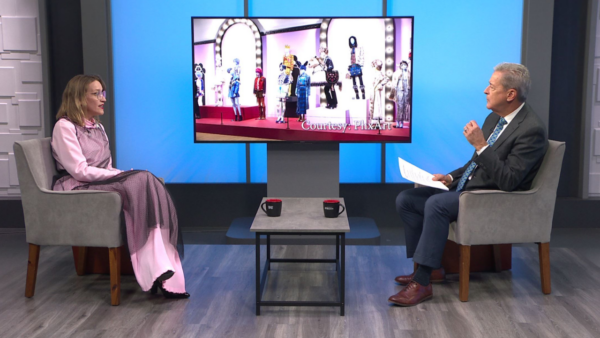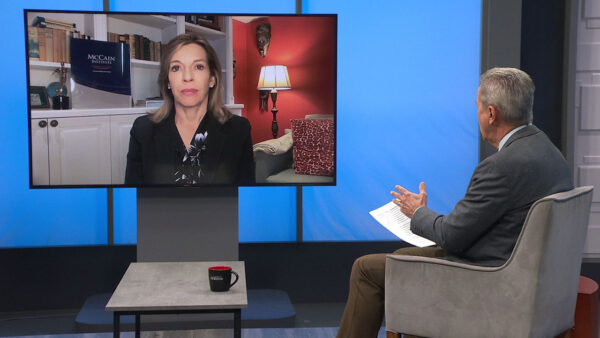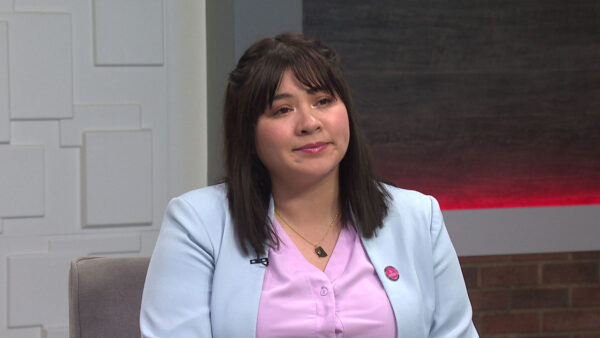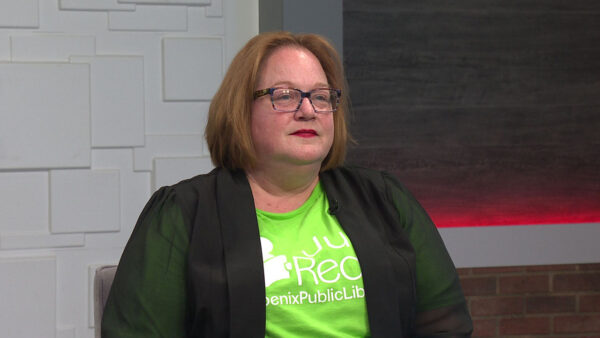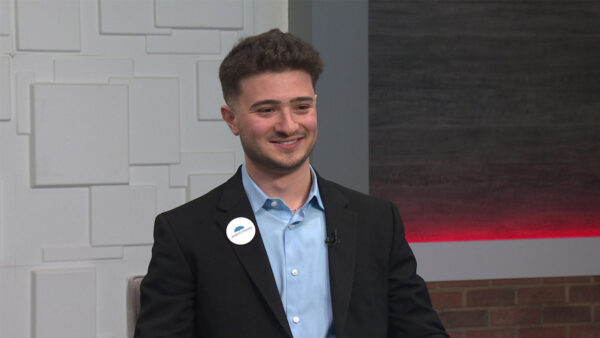Colonel Smith Middle School, on Fort Huachuca in southern Arizona near Sierra Vista, is the State’s first Net Zero Energy school, and only the 12th Net Zero Energy building in the nation. Learn more about the sustainable design of this school from Ronda Frueauff, Superintendent of Fort Huachuca Schools and Tony Wall of 3-W Management, the company that managed the school’s construction.
Ted Simons: Tonight's edition of "Horizon's" focus on sustainability looks at the state's first net zero energy school. The colonel Smith middle school at Fort Huachuca in southern Arizona. Joining us is Dr. Ronda Frueauff, superintendent of the Fort Huachuca accommodation school district, and Tony Wall, president of 3W management, the company that supervisors the school's construction. Good to have you both here.
Ronda Frueauff: Good to be here.
Ted Simons: Net zero energy building. What are we talking about here?
Rond Frueauff: It's a building that's designed to create as much energy as it utilizes to function and operate.
Ted Simons: Does it really zero out, or can you have a little more and sell it back to the grid?
Ronda Frueauff: Mr. Wall can answer that directly.
Ted Simons: Mr. Wall, can you answer that for us?
Tony Wall: It's design to zero out. We prefer not to sell it back to the grid. But the idea of producing as much as you use is the concept of net zero.
Ted Simons: And how would you produce that energy?
Tony Wall: We produce that through solar, and through wind turbines that produce energy in our school.
Ted Simons: These -- solar can be focused, the wind turbines focused just on that school, or regionally?
Tony Wall: Just on our school. They're small, primarily for demonstration for student purposes. They'll create 1-3% of the energy production for our school usage. But they're there for students to see and understand how they operate.
Ted Simons: We're looking at one right now. They're on the landscape. Beautiful structures. Why Fort Huachuca? Why this school?
Ronda Frueauff: We are in the process of replacing three of the schools that were on the post that were 40 to 50 years old. I replaced two of them already, ones a primary building, ones an elementary -an intermediate elementary building so when it came time to build the middle school, we wanted to look at sustainability and a building that was project spaced and in focused. So it's designed with all of those pieces in mind.
Ted Simons: And the kids at the school as it was referred to earlier, they learned about energy systems literally out the window. Or actually underneath the system, because they're outdoors as well.
Ronda Frueauff: Exactly. We put in a number of features into the school that would allow the students to be able to engage about energy conservation, one of those is an energy dashboard that will measure 37 energy sources. And the students can monitor all the electricity being utilized, it can measure the wind and how it's impacting our electrical grid, and it will also measure the water harvesting, because we have two water harvesting tanks we use for irrigation.
Ted Simons: When you're designing something like this, thinking something like this through, where do these ideas come from? Talk to us about the goals and the whole design aspect.
Tony Wall: Well, the vision for this school came from Ronda's research and instruction, and her 30 years of experience as an educator. We designed this building to that vision, and our team, which was very broad, very experienced, very multidisciplinary, understood that we had the opportunity to create something special. That encompassed so many different things. And a number of schools across the country have an element of what we have. But we've taken all of those elements and brought it together to create this wonderful school.
Ted Simons: What kind of challenges did you face early on and through the process?
Tony Wall: Harnessing our expertise of our big team.
Ted Simons: Interesting.
Tony Wall: And that drove us to really use the instructional program and the instructional vision as the key for implementation.
Ted Simons: It sounds like you kind of had some ideas there, and you threw those ideas out and they caught them. Where did your ideas come from? What set you off on this?
Ronda Frueauff: Well, one of the things that I've learned after 34 years in this business is that in order to engage students, you have to have an environment that is inviting and engaging. And one that asks them to become architects of their own learning. So when I was given an opportunity to do this in this particular setting, I was able to write a concept paper that my governing board actually reviewed and understood, and supported, and then we were able to begin to talk about what kind of space, what kind of furniture, what kind of tools &, instructional tools that are appropriate for this type of environment, and with that, once I got a room full of people who built schools and had designed schools, and had done parts and pieces, they were able to put this together into one special place.
Ted Simons: So you said instead of classrooms I want collaborative areas, I want indoor-outdoor learning, these are the kinds of ideas you had.
Ronda Frueauff: I want everything to be a learning environment from the moment they get off the school bus until the time they walk out of the building.
Ted Simons: And if those are among the goals, how does that get done? What's the process?
Tony Wall: We changed the vocabulary. It's not a classroom, it's a flexible learning space. Flexible learning spaces are adjacent to collaboration areas. It gives teachers the opportunity to put students in groups and to move them throughout the day. They're not a rigid place for students to be. This is the apple store with teachers. This is an environment that is different than most schools have, and it's much more engaging for children.
Ted Simons: It's engaging for children, also if you're constructing the building, you've got to make sure it's focused in the right direction, is it east-west as opposed to north-south? Were those things put into play?
Tony Wall: They absolutely were. Daylighting is a key part of our net zero aspect. And most days classroom lights are not on. We have enough natural lights coming into the building that we don't need classroom lights on. That's a tremendous energy savings. That's a cost savings and a bottom line for the school district. In an operating budget that has dollars that can be pushed back to the classroom.
Ted Simons: What kind of response are you getting from parents, from teachers, from students?
Ronda Frueauff: The students were engaged in the design process, and they were on our design team. And they actually were in dialogue groups as we moved through the planning process so they could say, I like the idea, I don't like the idea. One of the things that of course interested them is that they do have an iPad as part of their instructional program, and they utilize that and can use that in their instructional program just as they would any other instructional tool. So they were excited about that, and then they were excited about the fact that their furniture in the rooms and classrooms is all mobile and flexible and movable. They could set up areas and there's lots of soft furniture. It has higher education air about it so they feel more independent. And a lot more engaged about being responsible for their educational program.
Ted Simons: It looks amazing, but how viable is this for other schools in other districts? The cost, the viability of getting this done?
Tony Wall: This school is not tremendously expensive in comparison to others across the country. We've had visitors who come in and believe our costs per square foot is very solid in that respect. We have worked to spend our money wisely. We worked to make this an educational program that meets our Fort Huachuca community. We think it's a program that is able to be repeated in other districts, depending on their specific circumstances.
Ted Simons: And repeated with other buildings I would imagine, libraries, and businesses and these sorts of things. But net zero, I would imagine just making it net zero has to increase the cost a little bit.
Tony Wall: It does.
Ted Simons: Is it the kind of thing you think most districts could handle?
Tony Wall: They can, because we're able to use power purchase agreements in order to offset some of the costs of the photovoltaic units. It's a partnership with a company that finances your panels, then that money goes back as a part of the electrical grid, and so there's an exchange of those dollars. So we are allowed to put those on a building and they will generate the energy, and then our operations cost, when you start taking energy costs out much your budget, you can offset some of the cost of your facility in order to be able to do that as well. So there's a return here. But it does take every one on the team talking about how do we design a more efficient building, and how do we make this building a building that is a learning facility.
Ted Simons: And if more are going to be built, costs generally up, down, stable?
Tony Wall: Costs are stable right now.
Ted Simons: Right now.
Tony Wall: Material costs are rising. Labor costs are fairly stable. In the future it will probably continue to rise with the economy.
Ted Simons: Interesting. Last question, I wanted to get the reaction of parents and students and teachers. The teachers and the parents especially, this is very new. Collaborative this, and open air that, that's not the same as chalkboard and take your seats kind of thing. How are they responding?
Ronda Frueauff: One of the things that helped us is our concept. We are on Fort Huachuca, which is an army base that focuses on technology and engineering, and communications. And is staffed by a lot of contractors who have field of study in science. So they support the focus, they support the educational environment. So it's for a group of students who really are going to be engaged and move around this country, and it is about the parents getting a really good educational opportunity for their children.
Ted Simons: Sounds fascinating. It's good to have you both here to explain it. Thank you so much for joining us.
Ronda Frueauff and Tony Wall: Thank you.
Ronda Frueauff:Superintendent, Fort Huachuca Schools; Tony Wall:3-W Management;



















